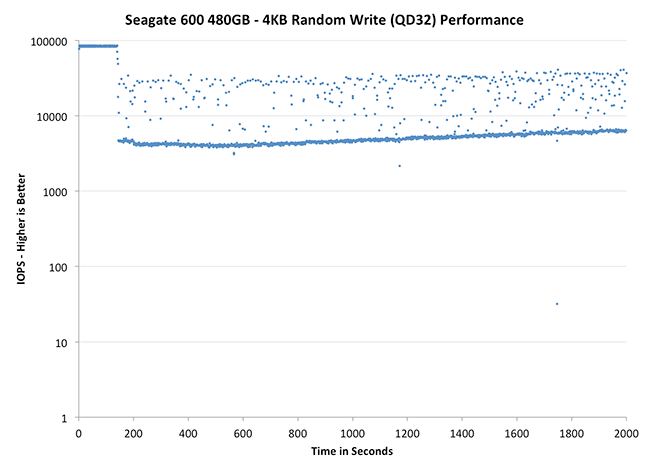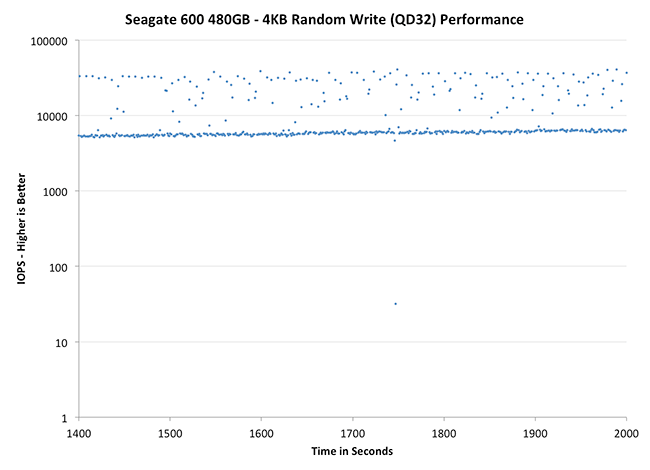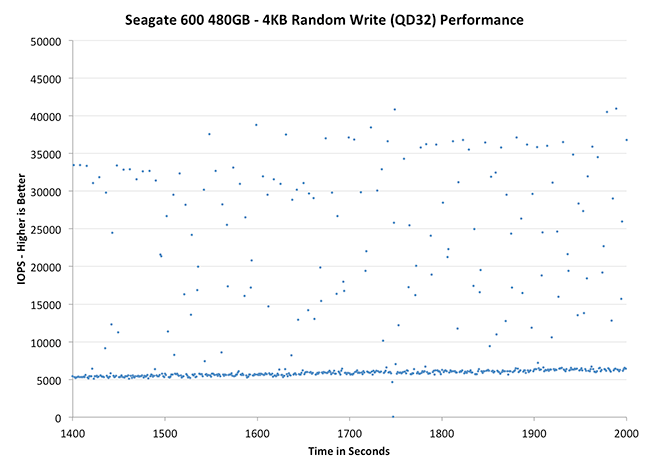The Seagate 600 & 600 Pro SSD Review
by Anand Lal Shimpi on May 7, 2013 8:00 AM ESTPerformance Consistency
In our Intel SSD DC S3700 review I introduced a new method of characterizing performance: looking at the latency of individual operations over time. The S3700 promised a level of performance consistency that was unmatched in the industry, and as a result needed some additional testing to show that. The reason we don't have consistent IO latency with SSDs is because inevitably all controllers have to do some amount of defragmentation or garbage collection in order to continue operating at high speeds. When and how an SSD decides to run its defrag and cleanup routines directly impacts the user experience. Frequent (borderline aggressive) cleanup generally results in more stable performance, while delaying that can result in higher peak performance at the expense of much lower worst case performance. The graphs below tell us a lot about the architecture of these SSDs and how they handle internal defragmentation.
To generate the data below I took a freshly secure erased SSD and filled it with sequential data. This ensures that all user accessible LBAs have data associated with them. Next I kicked off a 4KB random write workload across all LBAs at a queue depth of 32 using incompressible data. I ran the test for just over half an hour, no where near what we run our steady state tests for but enough to give me a good look at drive behavior once all spare area filled up.
I recorded instantaneous IOPS every second for the duration of the test. I then plotted IOPS vs. time and generated the scatter plots below. Each set of graphs features the same scale. The first two sets use a log scale for easy comparison, while the last set of graphs uses a linear scale that tops out at 50K IOPS for better visualization of differences between drives.
The high level testing methodology remains unchanged from our S3700 review. Unlike in previous reviews however, I did vary the percentage of the drive that I filled/tested depending on the amount of spare area I was trying to simulate. The buttons are labeled with the advertised user capacity had the SSD vendor decided to use that specific amount of spare area. If you want to replicate this on your own all you need to do is create a partition smaller than the total capacity of the drive and leave the remaining space unused to simulate a larger amount of spare area. The partitioning step isn't absolutely necessary in every case but it's an easy way to make sure you never exceed your allocated spare area. It's a good idea to do this from the start (e.g. secure erase, partition, then install Windows), but if you are working backwards you can always create the spare area partition, format it to TRIM it, then delete the partition. Finally, this method of creating spare area works on the drives we've tested here but not all controllers may behave the same way.
The first set of graphs shows the performance data over the entire 2000 second test period. In these charts you'll notice an early period of very high performance followed by a sharp dropoff. What you're seeing in that case is the drive allocating new blocks from its spare area, then eventually using up all free blocks and having to perform a read-modify-write for all subsequent writes (write amplification goes up, performance goes down).
The second set of graphs zooms in to the beginning of steady state operation for the drive (t=1400s). The third set also looks at the beginning of steady state operation but on a linear performance scale. Click the buttons below each graph to switch source data.
 |
|||||||||
| Corsair Neutron 240GB | Crucial M500 960GB | Samsung SSD 840 Pro 256GB | Seagate 600 480GB | Seagate 600 Pro 400GB | |||||
| Default | |||||||||
| 25% Spare Area | |||||||||
Now this is a bit surprising. I expected a tightly clustered group of IOs like we got with the LAMD based Corsair Neutron, but instead we see something different entirely. There's a clustering of IOs around the absolute minimum performance, but it looks like the controller is constantly striving for better performance. If there's any indication that Seagate's firmware is obviously different than what Corsair uses, this is it. If we look at the 400GB Seagate 600 Pro we get a good feel for what happens with further over provisioning. The 400GB Pro maintains consistently high performance for longer than the 480GB 600, and when it falls off the minimums are also higher as you'd expect.
 |
|||||||||
| Corsair Neutron 240GB | Crucial M500 960GB | Samsung SSD 840 Pro 256GB | Seagate 600 480GB | Seagate 600 Pro 400GB | |||||
| Default | |||||||||
| 25% Spare Area | |||||||||
Zooming in, the Seagate 600 definitely doesn't look bad - it's far better than the Samsung or Crucial offerings, but still obviously short of Corsair's Neutron. I almost wonder if Seagate prioritized peak performance a bit here in order to be more competitive in most client benchmarks.
 |
|||||||||
| Corsair Neutron 240GB | Crucial M500 960GB | Samsung SSD 840 Pro 256GB | Seagate 600 480GB | Seagate 600 Pro 400GB | |||||
| Default | |||||||||
| 25% Spare Area | |||||||||
The situation really looks a lot worse than it is here. The 600's performance isn't very consistent, but there's a clear floor at just above 5000 IOPS which is quite respectable. Compared to the Crucial and Samsung drives, the 600/600 Pro offer much better performance consistency. I do wish that Seagate had managed to deliver even more consistent performance given that we know what the controller is capable of. For client usage I suspect this won't matter, but in random write heavy enterprise workloads with large RAID arrays it isn't desirable behavior.










59 Comments
View All Comments
Kristian Vättö - Wednesday, May 8, 2013 - link
I need to speak with Anand but $60 definitely doesn't sound too bad :-) Ultimately I think a meter that could log data e.g. every 100ms and the data could easily be import to Excel would be ideal as then we could easily make a graph of power usage over time, but knowing the overall usage would still be better than what we have now. Thanks for the suggestion!GamerGirl - Thursday, May 9, 2013 - link
wow this is really so fast...19nm of nand its ok for longlife?MelodyRamos47 - Sunday, May 12, 2013 - link
before I saw the draft 4 $9944, I did not believe ...that...my mother in law was like they say actually erning money in their spare time at their laptop.. there aunt started doing this 4 only fifteen months and by now cleard the mortgage on there villa and bourt a great new Chrysler. we looked here, Jump44.comCHECK IT OUTbards1888 - Monday, May 13, 2013 - link
A local supplier has this part in stock, ST480FN0021. It does not appear to be the 600 Pro as it has part number ST480FP0021.Does anyone know the difference ?
vdidenko - Wednesday, May 29, 2013 - link
I am known to fill up all storage available, so it will be hard to stick to the 10-20% free space rule for me. However, would partitioning the disk so that 20% of it is not allocated to a partition do the trick technologically? It surely will force me...aSSDtech - Tuesday, July 2, 2013 - link
I don't think 4 Tantulium Capacitors can make SSDs suvive upon sudden host power loss. 4*470uF can not meet the power of the SSD needs because the power comsumption is generally 4W and the data needs to be flushed down are more than 4 seconds because the DRAMs and the write speed.RaresIonut - Wednesday, December 11, 2013 - link
Hi,Very nice review!
I ordered a Seagate s600 120GB and I should get it by tomorow.
There's one thing that bothers me regarding ssd's (particulary mine): does the Seagate s600 120GB have TRIM support? Does it need TRIM support?
Sorry if this was mentioned somewhere in the article, I'm reading iton a bus :(
Thank you! :)
drben - Wednesday, December 18, 2013 - link
Sisco Chemicals Inc.:leads in SSD automatic chemical solution for cleaning black money and any color of defaced currency is available in our laboratory worldwide. Our S.S.D Automatic solution is also used in the cleaning of stained bank notes with anti breeze quality, bills like USD, euro, pounds and other local currency.We are direct manufacturer and main supplier of all kinds of chemicals which include SSD Solution ,
Super Automatic Solution.we have different types of chemicals that can perfectly clean out your Deface note, Black note , Red notes ,Green notes ,Stained notes ,Stamped notes and also coded notes We also melt frozen chemicals in our laboratory and our services are professional We thus Provide legal document for all our product.
Email ssdsiscochemicals@doctor.com
Mobile: +918447250476
Address:No.9 Boat Club Road,Raja Annamalai Puram Chennai,TN
Name: DR Ben Bruce
Sisco Chemnicals Inc.
Delicate - Monday, January 20, 2014 - link
As per this article - http://www.techarena.in/review/258133-seagate-600-... in the Indian market this hard drive is way to costly which comes at Rs. 9000. Being a hard drive for extreme pc and gaming does not mean that it should be so much costly.